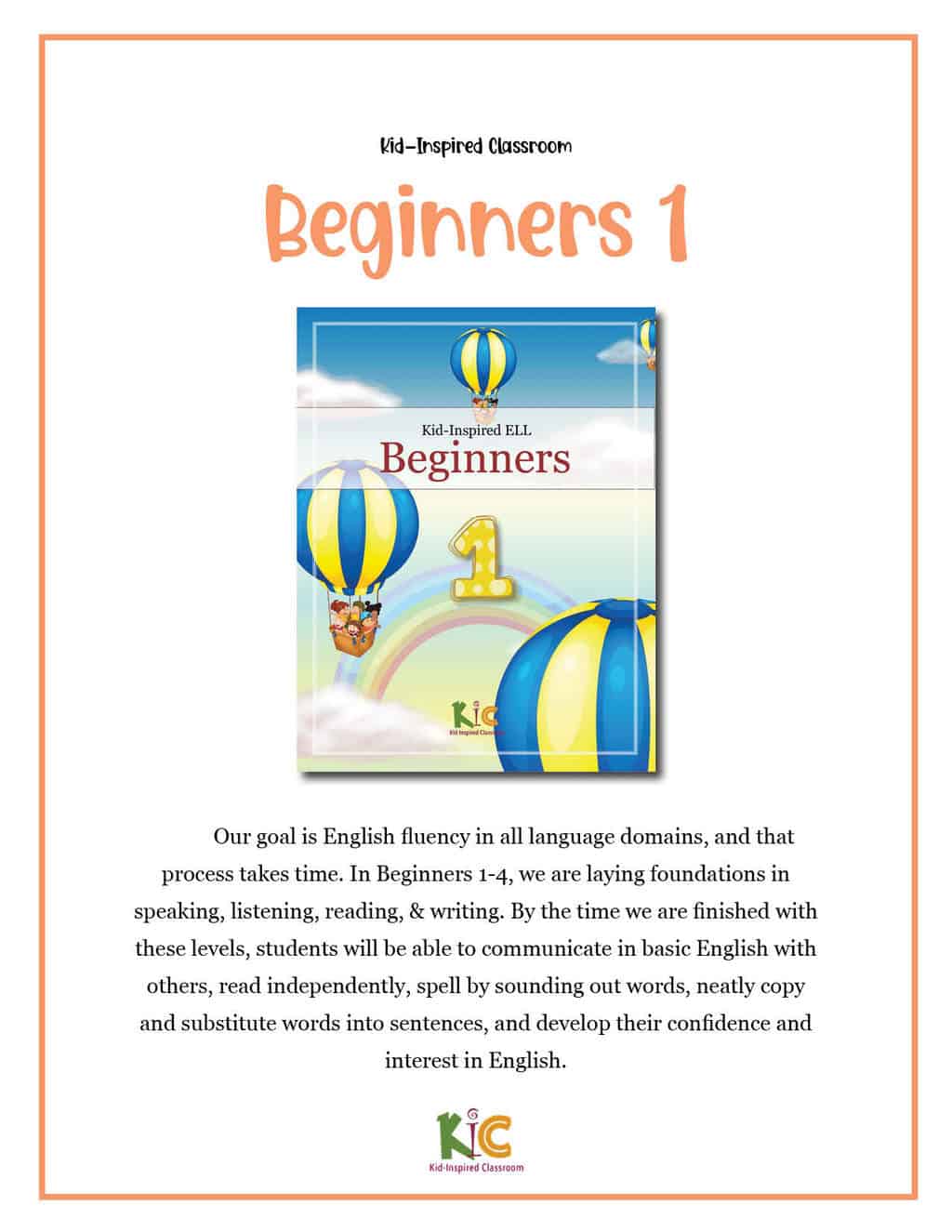Level Overview

This interactive Level Overview PDF Pack includes:
- Level Outline & Objectives
- Links to Units & Lessons
- Related Resources
Beginners 1 Overview
Beginners 1 Goals
These are the main goals of Beginners 1. You can download the Beginners 1 Paths to Fluency Tracker to help track students' progress towards these goals.
Beginners 1 Tips
1. Each unit at this level was designed for 1 week with about 3 hours of class time per week. If you have your students for less than 3 hours a week, you may want to consider doing a unit every two weeks. If the speaking is easy for your students and they are retaining the phonics well, you can probably speed up the pace.
2. First Class or Two: Since students are usually starting this level with zero English, you will want to spend the first class or two setting up good routines with your students. Once your students can understand basic classroom commands and can communicate basic needs, you can spend more time focusing on the phonics.
3. Units 1-5 cover the alphabet. The alphabet is often under-taught. We want them to be absolutely fluent with the alphabet, not just able to sing the alphabet song. You will want them recognizing alphabet letter names and sounds easily at a pace of around 45 letters a minute. You will want to spend quite a bit of time practicing the letters mixed up as you progress. You can do this using the flashcards in each unit or the flash cards in the phonics section of the teacher tools.
4. Units 6-15 cover short vowel words. The better students know their alphabet letter sounds, the easier short-vowel reading will be. Your goal is to get them up to around 20 short-vowel words a minute by the end of Beginners 1. You can keep going back and practicing the alphabet letters even after you get into short-vowel reading, but short-vowel reading is one of the absolute best ways to practice the alphabet.
5. Train students to listen. If you are saying something the students have learned before, try to avoid using gestures. We often gesticulate without even thinking about it. Students can come to over-rely on their eyes for understanding rather than their ears. If they're struggling to understand, by all means, gesticulate away, but give them the chance to practice their listening beforehand by putting your hands behind your back and repeating yourself a couple of times.
6. Stronger Speakers. The speaking practices in Beginners 1 are generally survival English phrases. If you find that the speaking material is too easy but students need the phonics, then double down on the phonics and skip the speaking pages. You can have a time each class where students get together with a partner to talk about a particular topic instead. That said, even if students pick up the speaking practices quickly, it is still great vocabulary and sentence structure review for them.
7. If your students are older (Grades 5-12), they can handle (and probably require) a quicker pace. You can just pull the phonics word family lists from this level and pair them with a higher level's material, or you can pull the phonics word family lists and work through a few of them each class so that you make quick progress through the phonics the students need to learn.
Beginners 1 Lesson Planning
Beginners 1 Overview
- Unit 1: Numbers, Greetings, Basic Classroom Commands
- Unit 2: Classroom Items, Letters A-G
- Unit 3: Basic Commands, Letters H-M
- Unit 4: Common Classroom Phrases, Letters N-T
Assessments Set 1
- Unit 5: Do you like...?, Letters U-Z
- Unit 6: How many...do you have?, Short a Phonics
- Unit 7: Common Classroom Phrases, Short a Phonics (cont)
- Unit 8: Playing Games, Short a Phonics (cont)
Assessments Set 2
- Unit 9: Movements, Short o Phonics
- Unit 10: Do you have a...?, Short i Phonics
- Unit 11: Do you have a...at home?, Short i Phonics (cont)
- Unit 12: I am..., Short u Phonics
Assessments Set 3
- Unit 13: What color is it?, Short u Phonics (cont)
- Unit 14: What color is it? (Colors Continued), Short e Phonics
- Unit 15: Numbers 11-20, Short e Phonics (cont)
Assessments Set 4
Other Helpful Links




hi, I can’t locate the activity(ies) pages for Step 1:Teach It for Beginners 1-3 Survival English Lesson Plans, which is the Whole group/pairs/small groups part of the lesson. Where can I find those pages? Thank you!
Hi Elena, I apologize for not seeing this earlier. I’m not sure if I have understood the question correctly, but the Survival English lessons for Beginners 1-3 are here: https://member.kid-inspired.com/memb_materials/numbers-1-10-b1-01/, https://member.kid-inspired.com/memb_materials/i-need-a-please/, and https://member.kid-inspired.com/memb_materials/basics-sit-properly/. There is some variety from lesson to lesson depending on the kind of content included. Some are vocabulary with a sentence structure while others are just commonly used phrases. Some adjustment is needed from lesson to lesson. For a quicker response, you can always contact support by using the bubble at the bottom of the screen if you have any other questions. All my best to you and your students.
Hello! It seems like the low intermediate 4 is missplaced, where could I find it?
Hi Claudia, I’ve fixed the link on the homepage so it should take you to the correct place now. Here’s a direct link though just in case: https://member.kid-inspired.com/memb_materials/low-intermediate-4-level-introduction/